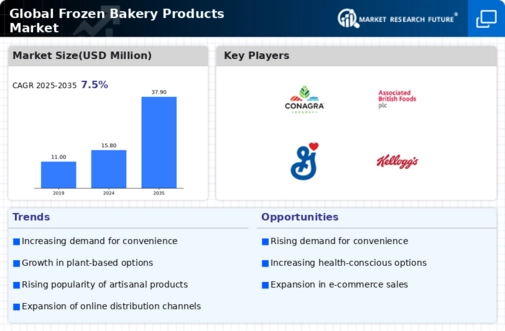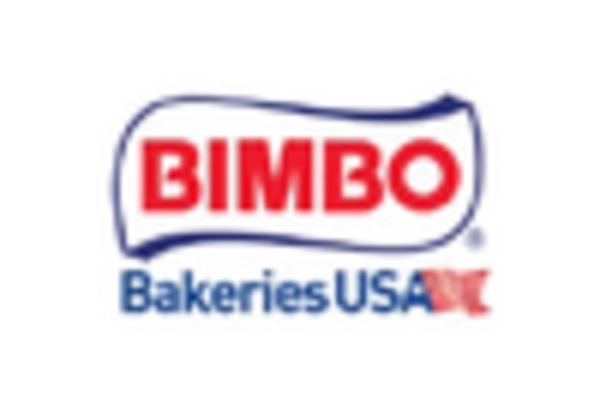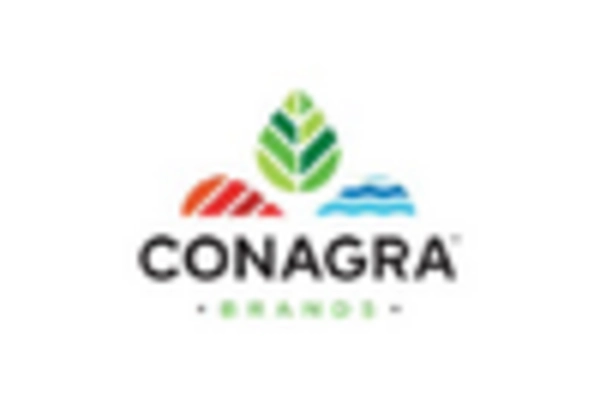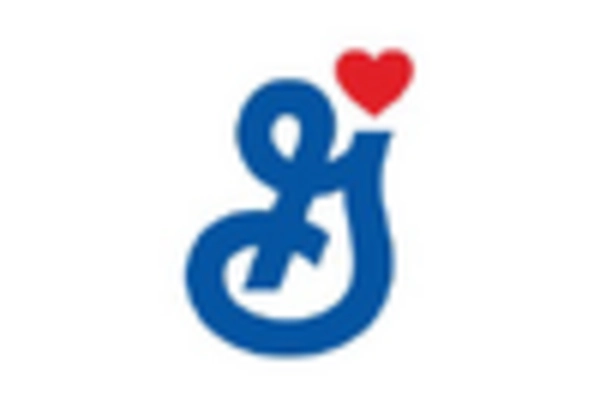-
MARKET ATTRACTIVENESS ANALYSIS 16
-
GLOBAL FROZEN BAKERY PRODUCTS MARKET, BY PRODUCT TYPE 17
-
GLOBAL FROZEN BAKERY PRODUCTS MARKET, BY CATEGORY 18
-
GLOBAL FROZEN BAKERY PRODUCTS MARKET, BY DISTRIBUTION CHANNEL 19
-
GLOBAL FROZEN BAKERY PRODUCTS MARKET, BY REGION 20
-
MARKET INTRODUCTION
-
DEFINITION 21
-
SCOPE OF THE STUDY 21
-
RESEARCH OBJECTIVE 21
-
MARKET STRUCTURE 22
-
KEY BUYING CRITERIA 22
-
RESEARCH METHODOLOGY
-
RESEARCH PROCESS 23
-
PRIMARY RESEARCH 24
-
SECONDARY RESEARCH 25
-
MARKET SIZE ESTIMATION 26
-
FORECAST MODEL 27
-
LIST OF ASSUMPTIONS 28
-
MARKET DYNAMICS
-
OVERVIEW 29
-
DRIVERS 30
- RISING DEMAND FOR CONVENIENCE FOOD 30
- INCREASING NUMBER OF WORKING WOMEN 30
- GROWTH OF THE ORGANIZED RETAIL SECTOR IN ASIA-PACIFIC 30
-
RESTRAINT 32
- HIGH PRODUCT COST 32
-
OPPORTUNITIES 33
- DEVELOPMENT OF THE COLD CHAIN MARKET IN EMERGING ECONOMIES 33
- DEMAND FOR ORGANIC PRODUCTS 33
-
CHALLENGE 33
- BRANDING ISSUES 33
-
MARKET FACTOR ANALYSIS
-
VALUE CHAIN ANALYSIS 34
- RAW MATERIAL PROCUREMENT 35
- PROCESSING 35
- PACKAGING 35
-
SUPPLY CHAIN ANALYSIS 36
-
PORTER’S FIVE FORCES MODEL 37
- THREAT OF NEW ENTRANTS 38
- BARGAINING POWER OF SUPPLIERS 38
- BARGAINING POWER OF BUYERS 38
- THREAT OF SUBSTITUTES 38
- INTENSITY OF RIVALRY 38
-
IMPACT OF THE COVID-19 OUTBREAK ON THE GLOBAL FROZEN BAKERY PRODUCTS MARKET
-
FROZEN BAKERY PRODUCTS MARKET, BY PRODUCT TYPE
-
OVERVIEW 40
- GLOBAL FROZEN BAKERY PRODUCTS MARKET ESTIMATES & FORECAST, | BY PRODUCT TYPE, 2020–2027 41
-
BREADS & ROLLS 42
- BREADS & ROLLS: MARKET ESTIMATES & FORECAST, BY REGION, 2020–2027 42
-
PIZZA & PIZZA CRUST 43
- PIZZA & PIZZA CRUST: MARKET ESTIMATES & FORECAST, BY REGION, 2020–2027 43
-
CAKES & PASTRIES 44
- CAKES & PASTRIES: MARKET ESTIMATES & FORECAST, BY REGION, 2020–2027 44
-
COOKIES & BISCUITS 45
- COOKIES & BISCUITS: MARKET ESTIMATES & FORECAST, BY REGION, 2020–2027 45
-
OTHERS 46
- OTHERS: MARKET ESTIMATES & FORECAST, BY REGION, 2020–2027 46
-
FROZEN BAKERY PRODUCTS MARKET, BY CATEGORY
-
OVERVIEW 47
- GLOBAL FROZEN BAKERY PRODUCTS MARKET ESTIMATES & FORECAST, BY CATEGORY, 2020–2027 48
-
CONVENTIONAL 48
- CONVENTIONAL: MARKET ESTIMATES & FORECAST, BY REGION, 2020–2027 48
-
GLUTEN-FREE 49
- GLUTEN-FREE: MARKET ESTIMATES & FORECAST, BY REGION, 2020–2027 49
-
FROZEN BAKERY PRODUCTS MARKET, BY DISTRIBUTION CHANNEL
-
OVERVIEW 50
- GLOBAL FROZEN BAKERY PRODUCTS MARKET ESTIMATES & FORECAST, BY DISTRIBUTION CHANNEL, 2020–2027 51
-
STORE-BASED 52
- STORE-BASED: MARKET ESTIMATES & FORECAST, BY REGION, 2020–2027 52
-
NON-STORE-BASED 53
- NON-STORE-BASED: MARKET ESTIMATES & FORECAST, BY REGION, 2020–2027 53
-
GLOBAL FROZEN BAKERY PRODUCTS MARKET, BY REGION
-
OVERVIEW 54
-
NORTH AMERICA 56
-
FROZEN BAKERY PRODUCTS MARKET, BY PRODUCT TYPE
-
FROZEN BAKERY PRODUCTS MARKET, BY CATEGORY
-
FROZEN BAKERY PRODUCTS MARKET, BY DISTRIBUTION CHANNEL
-
US 58
-
FROZEN BAKERY PRODUCTS MARKET, BY PRODUCT TYPE
-
FROZEN BAKERY PRODUCTS MARKET, BY CATEGORY
-
FROZEN BAKERY PRODUCTS MARKET, BY DISTRIBUTION CHANNEL
-
CANADA 60
-
FROZEN BAKERY PRODUCTS MARKET, BY PRODUCT TYPE
-
FROZEN BAKERY PRODUCTS MARKET, BY CATEGORY
-
FROZEN BAKERY PRODUCTS MARKET, BY DISTRIBUTION CHANNEL
-
MEXICO 61
-
FROZEN BAKERY PRODUCTS MARKET, BY PRODUCT TYPE
-
FROZEN BAKERY PRODUCTS MARKET, BY CATEGORY
-
FROZEN BAKERY PRODUCTS MARKET, BY DISTRIBUTION CHANNEL
-
EUROPE 63
-
FROZEN BAKERY PRODUCTS MARKET, BY PRODUCT TYPE
-
FROZEN BAKERY PRODUCTS MARKET, BY CATEGORY
-
FROZEN BAKERY PRODUCTS MARKET, BY DISTRIBUTION CHANNEL
-
UK 66
-
FROZEN BAKERY PRODUCTS MARKET, BY PRODUCT TYPE
-
FROZEN BAKERY PRODUCTS MARKET, BY CATEGORY
-
FROZEN BAKERY PRODUCTS MARKET, BY DISTRIBUTION CHANNEL
-
GERMANY 67
-
FROZEN BAKERY PRODUCTS MARKET, BY PRODUCT TYPE
-
FROZEN BAKERY PRODUCTS MARKET, BY CATEGORY
-
FROZEN BAKERY PRODUCTS MARKET, BY DISTRIBUTION CHANNEL
-
FRANCE 69
-
FROZEN BAKERY PRODUCTS MARKET, BY PRODUCT TYPE
-
FROZEN BAKERY PRODUCTS MARKET, BY CATEGORY
-
FROZEN BAKERY PRODUCTS MARKET, BY DISTRIBUTION CHANNEL
-
ITALY 70
-
FROZEN BAKERY PRODUCTS MARKET, BY PRODUCT TYPE
-
FROZEN BAKERY PRODUCTS MARKET, BY CATEGORY
-
FROZEN BAKERY PRODUCTS MARKET, BY DISTRIBUTION CHANNEL
-
SPAIN 72
-
FROZEN BAKERY PRODUCTS MARKET, BY PRODUCT TYPE
-
FROZEN BAKERY PRODUCTS MARKET, BY CATEGORY
-
FROZEN BAKERY PRODUCTS MARKET, BY DISTRIBUTION CHANNEL
-
DENMARK 73
-
FROZEN BAKERY PRODUCTS MARKET, BY PRODUCT TYPE
-
FROZEN BAKERY PRODUCTS MARKET, BY CATEGORY
-
FROZEN BAKERY PRODUCTS MARKET, BY DISTRIBUTION CHANNEL
-
NORWAY 75
-
FROZEN BAKERY PRODUCTS MARKET, BY PRODUCT TYPE
-
FROZEN BAKERY PRODUCTS MARKET, BY CATEGORY
-
FROZEN BAKERY PRODUCTS MARKET, BY DISTRIBUTION CHANNEL
-
SWEDEN 76
-
FROZEN BAKERY PRODUCTS MARKET, BY PRODUCT TYPE
-
FROZEN BAKERY PRODUCTS MARKET, BY CATEGORY
-
FROZEN BAKERY PRODUCTS MARKET, BY DISTRIBUTION CHANNEL
-
FINLAND 78
-
FROZEN BAKERY PRODUCTS MARKET, BY PRODUCT TYPE
-
FROZEN BAKERY PRODUCTS MARKET, BY CATEGORY
-
FROZEN BAKERY PRODUCTS MARKET, BY DISTRIBUTION CHANNEL
-
REST OF EUROPE 79
-
FROZEN BAKERY PRODUCTS MARKET, BY PRODUCT TYPE
-
FROZEN BAKERY PRODUCTS MARKET, BY CATEGORY
-
FROZEN BAKERY PRODUCTS MARKET, BY DISTRIBUTION CHANNEL
-
ASIA-PACIFIC 81
-
FROZEN BAKERY PRODUCTS MARKET, BY PRODUCT TYPE
-
FROZEN BAKERY PRODUCTS MARKET, BY CATEGORY
-
FROZEN BAKERY PRODUCTS MARKET, BY DISTRIBUTION CHANNEL
-
CHINA 84
-
FROZEN BAKERY PRODUCTS MARKET, BY PRODUCT TYPE
-
FROZEN BAKERY PRODUCTS MARKET, BY CATEGORY
-
FROZEN BAKERY PRODUCTS MARKET, BY DISTRIBUTION CHANNEL
-
INDIA 85
-
FROZEN BAKERY PRODUCTS MARKET, BY PRODUCT TYPE
-
FROZEN BAKERY PRODUCTS MARKET, BY CATEGORY
-
FROZEN BAKERY PRODUCTS MARKET, BY DISTRIBUTION CHANNEL
-
JAPAN 87
-
FROZEN BAKERY PRODUCTS MARKET, BY PRODUCT TYPE
-
FROZEN BAKERY PRODUCTS MARKET, BY CATEGORY
-
FROZEN BAKERY PRODUCTS MARKET, BY DISTRIBUTION CHANNEL
-
SOUTH KOREA 88
-
FROZEN BAKERY PRODUCTS MARKET, BY PRODUCT TYPE
-
FROZEN BAKERY PRODUCTS MARKET, BY CATEGORY
-
FROZEN BAKERY PRODUCTS MARKET, BY DISTRIBUTION CHANNEL
-
AUSTRALIA & NEW ZEALAND 90
-
FROZEN BAKERY PRODUCTS MARKET, BY PRODUCT TYPE
-
FROZEN BAKERY PRODUCTS MARKET, BY CATEGORY
-
FROZEN BAKERY PRODUCTS MARKET, BY DISTRIBUTION CHANNEL
-
REST OF ASIA-PACIFIC 91
-
FROZEN BAKERY PRODUCTS MARKET, BY PRODUCT TYPE
-
FROZEN BAKERY PRODUCTS MARKET, BY CATEGORY
-
FROZEN BAKERY PRODUCTS MARKET, BY DISTRIBUTION CHANNEL
-
REST OF THE WORLD 93
-
FROZEN BAKERY PRODUCTS MARKET, BY PRODUCT TYPE
-
FROZEN BAKERY PRODUCTS MARKET, BY CATEGORY
-
FROZEN BAKERY PRODUCTS MARKET, BY DISTRIBUTION CHANNEL
-
SOUTH AMERICA 95
-
FROZEN BAKERY PRODUCTS MARKET, BY PRODUCT TYPE
-
FROZEN BAKERY PRODUCTS MARKET, BY CATEGORY
-
FROZEN BAKERY PRODUCTS MARKET, BY DISTRIBUTION CHANNEL
-
MIDDLE EAST 97
-
FROZEN BAKERY PRODUCTS MARKET, BY PRODUCT TYPE
-
FROZEN BAKERY PRODUCTS MARKET, BY CATEGORY
-
FROZEN BAKERY PRODUCTS MARKET, BY DISTRIBUTION CHANNEL
-
AFRICA 98
-
FROZEN BAKERY PRODUCTS MARKET, BY PRODUCT TYPE
-
FROZEN BAKERY PRODUCTS MARKET, BY CATEGORY
-
FROZEN BAKERY PRODUCTS MARKET, BY DISTRIBUTION CHANNEL
-
COMPETITIVE LANDSCAPE
-
INTRODUCTION 100
- MARKET STRATEGY ANALYSIS 100
-
COMPETITIVE BENCHMARKING 101
-
KEY DEVELOPMENTS & GROWTH STRATEGIES 102
- PRODUCT LAUNCH 102
- ACQUISITION 102
- EXPANSIONS 103
- PARTNERSHIP 103
-
COMPANY PROFILES
-
GRUPO BIMBO S.A.B. DE C.V 104
- COMPANY OVERVIEW 104
- FINANCIAL OVERVIEW 105
- PRODUCTS OFFERED 105
- KEY DEVELOPMENTS 106
- SWOT ANALYSIS 106
- KEY STRATEGIES 106
-
CONAGRA BRANDS, INC. 107
- COMPANY OVERVIEW 107
- FINANCIAL OVERVIEW 108
- PRODUCTS OFFERED 109
- KEY DEVELOPMENTS 109
- SWOT ANALYSIS 110
- KEY STRATEGIES 110
-
ASSOCIATED BRITISH FOODS PLC 111
- COMPANY OVERVIEW 111
- FINANCIAL OVERVIEW 111
- PRODUCTS OFFERED 112
- KEY DEVELOPMENTS 112
- SWOT ANALYSIS 112
- KEY STRATEGIES 113
-
GENERAL MILLS INC. 114
- COMPANY OVERVIEW 114
- FINANCIAL OVERVIEW 114
- PRODUCTS OFFERED 115
- KEY DEVELOPMENTS 115
- SWOT ANALYSIS 116
- KEY STRATEGIES 116
-
LANTMÄNNEN UNIBAKE 117
- COMPANY OVERVIEW 117
- FINANCIAL OVERVIEW 117
- PRODUCTS OFFERED 118
- KEY DEVELOPMENTS 118
- SWOT ANALYSIS 119
- KEY STRATEGIES 119
-
KELLOGG COMPANY 120
- COMPANY OVERVIEW 120
- FINANCIAL OVERVIEW 120
- PRODUCTS OFFERED 121
- KEY DEVELOPMENTS 121
- KEY STRATEGIES 121
-
ARYZTA AG 122
- COMPANY OVERVIEW 122
- FINANCIAL OVERVIEW 122
- PRODUCTS OFFERED 123
- KEY DEVELOPMENTS 123
- KEY STRATEGIES 123
-
VANDEMOORTELE NV 124
- COMPANY OVERVIEW 124
- FINANCIAL OVERVIEW 124
- PRODUCTS OFFERED 125
- KEY DEVELOPMENTS 125
- KEY STRATEGIES 125
-
EUROPASTRY S.A. 126
- COMPANY OVERVIEW 126
- FINANCIAL OVERVIEW 126
- PRODUCTS OFFERED 126
- KEY DEVELOPMENTS 127
- KEY STRATEGIES 127
-
COLE’S QUALITY FOODS INC 128
- COMPANY OVERVIEW 128
- FINANCIAL OVERVIEW 128
- PRODUCTS OFFERED 128
- KEY DEVELOPMENTS 128
- KEY STRATEGIES 128
-
REFERENCES
-
LIST OF TABLES
-
PRIMARY INTERVIEWS 24
-
LIST OF ASSUMPTIONS 28
-
GLOBAL FROZEN BAKERY PRODUCTS MARKET ESTIMATES & FORECAST, BY PRODUCT TYPE, 2020–2027 (USD MILLION) 41
-
BREADS & ROLLS: MARKET ESTIMATES & FORECAST, BY REGION, 2020–2027 (USD MILLION) 42
-
PIZZA & PIZZA CRUST: MARKET ESTIMATES & FORECAST, BY REGION, 2020–2027 (USD MILLION) 43
-
CAKES & PASTRIES: MARKET ESTIMATES & FORECAST, BY REGION, 2020–2027 (USD MILLION) 44
-
COOKIES & BISCUITS: MARKET ESTIMATES & FORECAST, BY REGION, 2020–2027 (USD MILLION) 45
-
OTHERS: MARKET ESTIMATES & FORECAST, BY REGION, 2020–2027 (USD MILLION) 46
-
GLOBAL FROZEN BAKERY PRODUCTS MARKET ESTIMATES & FORECAST, BY CATEGORY, 2020–2027 (USD MILLION) 48
-
CONVENTIONAL: MARKET ESTIMATES & FORECAST, BY REGION, 2020–2027 (USD MILLION) 48
-
GLUTEN-FREE: MARKET ESTIMATES & FORECAST, BY REGION, 2020–2027 (USD MILLION) 49
-
GLOBAL FROZEN BAKERY PRODUCTS MARKET ESTIMATES & FORECAST, BY DISTRIBUTION CHANNEL,
-
STORE-BASED: MARKET ESTIMATES & FORECAST, BY REGION, 2020–2027 (USD MILLION) 52
-
NON-STORE-BASED: MARKET ESTIMATES & FORECAST, BY REGION, 2020–2027 (USD MILLION) 53
-
GLOBAL FROZEN BAKERY PRODUCTS MARKET ESTIMATES & FORECAST, BY REGION, 2020–2027 (USD MILLION) 55
-
NORTH AMERICA: MARKET ESTIMATES & FORECAST, BY COUNTRY, 2020–2027 (USD MILLION) 56
-
NORTH AMERICA: FROZEN BAKERY PRODUCTS MARKET, BY PRODUCT TYPE, 2020–2027 (USD MILLION) 57
-
NORTH AMERICA: FROZEN BAKERY PRODUCTS MARKET, BY CATEGORY, 2020–2027 (USD MILLION) 57
-
NORTH AMERICA: FROZEN BAKERY PRODUCTS MARKET, BY DISTRIBUTION CHANNEL, 2020–2027 (USD MILLION) 58
-
US: FROZEN BAKERY PRODUCTS MARKET, BY PRODUCT TYPE, 2020–2027 (USD MILLION) 58
-
US: FROZEN BAKERY PRODUCTS MARKET, BY CATEGORY, 2020–2027 (USD MILLION) 59
-
US: FROZEN BAKERY PRODUCTS MARKET, BY DISTRIBUTION CHANNEL, 2020–2027 (USD MILLION) 59
-
CANADA: FROZEN BAKERY PRODUCTS MARKET, BY PRODUCT TYPE, 2020–2027 (USD MILLION) 60
-
CANADA: FROZEN BAKERY PRODUCTS MARKET, BY CATEGORY, 2020–2027 (USD MILLION) 60
-
CANADA: FROZEN BAKERY PRODUCTS MARKET, BY DISTRIBUTION CHANNEL, 2020–2027 (USD MILLION) 61
-
MEXICO: FROZEN BAKERY PRODUCTS MARKET, BY PRODUCT TYPE, 2020–2027 (USD MILLION) 61
-
MEXICO: FROZEN BAKERY PRODUCTS MARKET, BY CATEGORY, 2020–2027 (USD MILLION) 62
-
MEXICO: FROZEN BAKERY PRODUCTS MARKET, BY DISTRIBUTION CHANNEL, 2020–2027 (USD MILLION) 62
-
EUROPE: MARKET ESTIMATES & FORECAST, BY COUNTRY, 2020–2027 (USD MILLION) 64
-
EUROPE: FROZEN BAKERY PRODUCTS MARKET, BY PRODUCT TYPE, 2020–2027 (USD MILLION) 64
-
EUROPE: FROZEN BAKERY PRODUCTS MARKET, BY CATEGORY, 2020–2027 (USD MILLION) 65
-
EUROPE: FROZEN BAKERY PRODUCTS MARKET, BY DISTRIBUTION CHANNEL, 2020–2027 (USD MILLION) 65
-
UK: FROZEN BAKERY PRODUCTS MARKET, BY PRODUCT TYPE, 2020–2027 (USD MILLION) 66

















Leave a Comment